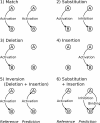Overview of the gene regulation network and the bacteria biotope tasks in BioNLP'13 shared task
- PMID: 26202448
- PMCID: PMC4511173
- DOI: 10.1186/1471-2105-16-S10-S1
Overview of the gene regulation network and the bacteria biotope tasks in BioNLP'13 shared task
Abstract
Background: We present the two Bacteria Track tasks of BioNLP 2013 Shared Task (ST): Gene Regulation Network (GRN) and Bacteria Biotope (BB). These tasks were previously introduced in the 2011 BioNLP-ST Bacteria Track as Bacteria Gene Interaction (BI) and Bacteria Biotope (BB). The Bacteria Track was motivated by a need to develop specific BioNLP tools for fine-grained event extraction in bacteria biology. The 2013 tasks expand on the 2011 version by better addressing the biological knowledge modeling needs. New evaluation metrics were designed for the new goals. Moving beyond a list of gene interactions, the goal of the GRN task is to build a gene regulation network from the extracted gene interactions. BB'13 is dedicated to the extraction of bacteria biotopes, i.e. bacterial environmental information, as was BB'11. BB'13 extends the typology of BB'11 to a large diversity of biotopes, as defined by the OntoBiotope ontology. The detection of entities and events is tackled by distinct subtasks in order to measure the progress achieved by the participant systems since 2011.
Results: This paper details the corpus preparations and the evaluation metrics, as well as summarizing and discussing the participant results. Five groups participated in each of the two tasks. The high diversity of the participant methods reflects the dynamism of the BioNLP research community.
Conclusion: The evaluation results suggest new research directions for the improvement and development of Information Extraction for molecular and environmental biology. The Bacteria Track tasks remain publicly open; the BioNLP-ST website provides an online evaluation service, the reference corpora and the evaluation tools.
Figures






Similar articles
-
Biomedical event extraction based on GRU integrating attention mechanism.BMC Bioinformatics. 2018 Aug 13;19(Suppl 9):285. doi: 10.1186/s12859-018-2275-2. BMC Bioinformatics. 2018. PMID: 30367569 Free PMC article.
-
Detection and categorization of bacteria habitats using shallow linguistic analysis.BMC Bioinformatics. 2015;16 Suppl 10(Suppl 10):S5. doi: 10.1186/1471-2105-16-S10-S5. Epub 2015 Jul 13. BMC Bioinformatics. 2015. PMID: 26201262 Free PMC article.
-
The contribution of co-reference resolution to supervised relation detection between bacteria and biotopes entities.BMC Bioinformatics. 2015;16 Suppl 10(Suppl 10):S6. doi: 10.1186/1471-2105-16-S10-S6. Epub 2015 Jul 13. BMC Bioinformatics. 2015. PMID: 26201352 Free PMC article.
-
Community challenges in biomedical text mining over 10 years: success, failure and the future.Brief Bioinform. 2016 Jan;17(1):132-44. doi: 10.1093/bib/bbv024. Epub 2015 May 1. Brief Bioinform. 2016. PMID: 25935162 Free PMC article. Review.
-
Symptom severity prediction from neuropsychiatric clinical records: Overview of 2016 CEGS N-GRID shared tasks Track 2.J Biomed Inform. 2017 Nov;75S:S62-S70. doi: 10.1016/j.jbi.2017.04.017. Epub 2017 Apr 25. J Biomed Inform. 2017. PMID: 28455151 Free PMC article. Review.
Cited by
-
Biomedical event extraction based on GRU integrating attention mechanism.BMC Bioinformatics. 2018 Aug 13;19(Suppl 9):285. doi: 10.1186/s12859-018-2275-2. BMC Bioinformatics. 2018. PMID: 30367569 Free PMC article.
-
Artificial Intelligence and Cardiovascular Genetics.Life (Basel). 2022 Feb 14;12(2):279. doi: 10.3390/life12020279. Life (Basel). 2022. PMID: 35207566 Free PMC article. Review.
-
Overview of the Cancer Genetics and Pathway Curation tasks of BioNLP Shared Task 2013.BMC Bioinformatics. 2015;16 Suppl 10(Suppl 10):S2. doi: 10.1186/1471-2105-16-S10-S2. Epub 2015 Jul 13. BMC Bioinformatics. 2015. PMID: 26202570 Free PMC article.
-
Text mining tools for extracting information about microbial biodiversity in food.Food Microbiol. 2019 Aug;81:63-75. doi: 10.1016/j.fm.2018.04.011. Epub 2018 Apr 21. Food Microbiol. 2019. PMID: 30910089 Free PMC article.
-
Detection and categorization of bacteria habitats using shallow linguistic analysis.BMC Bioinformatics. 2015;16 Suppl 10(Suppl 10):S5. doi: 10.1186/1471-2105-16-S10-S5. Epub 2015 Jul 13. BMC Bioinformatics. 2015. PMID: 26201262 Free PMC article.
References
-
- Kim JD, Ohta T, Pyysalo S, Kano Y, Tsujii J. Extracting bio-molecular events from literature - The BioNLP'09 Shared Task. Computational Intelligence. 2011;27(4):513–540. doi: 10.1111/j.1467-8640.2011.00398.x. - DOI
-
- Nédellec C, Bossy R, Kim JD, Kim JJ, Ohta T, Pyysalo S, Zweigenbaum P. Overview of BioNLP Shared Task 2013. Proceedings of the BioNLP Shared Task 2013 Workshop. 2013. pp. 1–7.
-
- Nédellec C. Learning Language in Logic - Genic Interaction Extraction Challenge. Proceedings of the Learning Language in Logic 2005 Workshop at the International Conference on Machine Learning. 2005. pp. 31–37.
Publication types
MeSH terms
LinkOut - more resources
Full Text Sources
Miscellaneous

